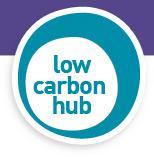
The Age Of Community Energy
With the price of energy rising at such a merciless rate, what is there to save us but the coming together of energy efficiency, renewable technology and community energy projects? By helping themselves and investing together in renewable energy, communities are finding independence and cheaper power for generations to come.
One of the frontrunners in UK community energy is Oxfordshire’s Low Carbon Hub, which is developing a model that may one day be replicated across the UK.

Below is a three-question interview with the Low Carbon Hub. As you read it, try to imagine how your own neighbourhood might benefit from such an organisation.
Q&A with the Low Carbon Hub
Q1. How did Low Carbon Hub come to be, and what is it designed to do ?
After the major summer floods of 2007 people in West Oxford wanted action on climate change but didn’t know what to do or how to go about it.
The result was a new community group – Low Carbon West Oxford or LCWO. Through the Big Green Challenge, LCWO received grants to engage the whole community, including businesses, to achieve 80% carbon reductions by 2050. With her energy background, Barbara Hammond was the key driver and had very ambitious plans to create renewable energy schemes locally.

This resulted in a new organisation called West Oxford Community Renewables or WOCoRe. Their first project was 50kW solar PV installation on Matthew Arnold School – the biggest on a school in Europe. This was followed by solar PV systems on roofs of the Kings Centre (a conference venue); ALDI supermarket; and a terrace of social housing. They even developed a small wind turbine at Hogacre Common.
The income generated from these projects through feed-in tariffs and electricity sales is used by the community to help residents reduce carbon emissions. This model of working is called "the double carbon cut" - i.e. renewable projects reduce emissions in themselves, but income from these schemes also fund further energy reduction projects. This way of working has now been replicated by other community projects locally and across the UK.
There are lots of potential groups like West Oxford across the county. Set up by Barbara Hammond, the Low Carbon Hub was launched in December 2011 to support other low carbon communities develop their own renewable energy schemes and reduce energy demand.
Q2. What services does LCH provide..?
The Low Carbon Hub is a social enterprise that works to lower carbon emissions across Oxfordshire by developing renewable energy (powering up*) and energy reduction (powering down**) projects for the benefit of local communities. The Hub team is made up of people who have worked, and are still working, with their communities so they understand and can help with the challenges in setting up and running these schemes.
Powering up*
The Hub’s expert powering up team, led by Barbara Hammond, helps community groups to develop renewable energy projects based on the natural resources of a particular area. Their Community Energy Service helps communities from feasibility, planning and tendering through to raising the finance and project completion.
The Hub can achieve maximum efficiency for community projects by working at scale with funders, installers and professional services – saving costs and maximising benefits. They currently have a pipeline of renewable schemes, including eight micro-hydro installations along the Upper Thames and solar photovoltaic schemes on community buildings, schools, churches and village halls.
Powering down**
The Hub’s powering down team team works through community groups to recruit households for energy efficiency assessments and improvements, enabling them to benefit from the best incentives and finance structures (such as Green Deal finance, Feed-in-Tariffs, Energy Company Obligation, and Renewable Heat Incentive).
By referring householders to trusted, local installers, the Hub aims to retrofit of homes in a way that benefits local community groups. The Hub are currently piloting approaches in Oxford City and county with several low carbon groups to work out the best way forward. This work is currently funded by the Department of Energy and Climate Change's Pioneer Green Places scheme.
… and some examples of ongoing projects?
49kW hydro scheme at Osney Lock, West Oxford
The Low Carbon Hub supported Osney Lock Hydro (OLH) to launch and market their share offer for the first community-owned hydro scheme in Oxfordshire, to be built in summer 2013. The scheme will harness the power of the Thames to generate 159,000kW of renewable electricity in the heart of Oxford, enough to power 50 homes, and save 83 tonnes of CO2per year.
The income from the sale of electricity and the feed-in tariff will give investors a financial return for their support and fund future community initiatives to further reduce carbon emissions. The share offer aimed to raise investment of £250,000 over a month but, in fact, OLH reached more than double their target in just three weeks.
18.65kW Solar PV installation on Eynsham Village Hall
In September 2012, Prime Minister, David Cameron launched the first community solar PV scheme for Eynsham and the Low Carbon Hub. Local environment group GreenTEA worked closely with the Hub to install 55 solar PV panels on the village hall and adjoining presbytery of St Peter’s.
This installation is owned and run by the Low Carbon Hub and will generate 10,535kW of clean, green electricity and save 5.8 tonnes of carbon per year. The village hall gets free electricity and the income from the feed-in tariff and the sale of surplus electricity funds other energy reduction initiatives in the area.
Q3. What is the potential for community energy projects - give us a vision of why might be, and why community energy is important.
Community energy is an important part of the UK energy picture. Secretary of State for Energy and Climate Change, Ed Davey, believes there is an appetite for a grassroots approach to energy and wants to "see nothing short of a community energy revolution" (Guardian, 6th June). And, DECC have just commissioned a call for evidence on community energy as they believe community energy is on the rise and there's potential to achieve more in the UK.
Research by Camco and Barker & Tilly estimates there is potential for over 2GW of community-owned renewables in England, or around ten per cent of the total capacity for onshore renewable energy. The potential for Scotland is estimated to be 1GW and for Wales 0.4GW. This means UK capacity could be around 3.5GW, the equivalent of three or four conventional power stations.
Community energy can be at all scales, from solar panels on the roof of a village hall – like the Hub's installation in Eynsham – to large scale wind energy developments, such as South Uist’s 7MW wind farm which will generate £20 million over the next 20 years.
Benefits of community energy schemes are:
Use of local resources: Locally-owned schemes are better at exploiting local resources like solar, biomass, farm waste, or wind sites which may be overlooked by commercial developers. They bring diversity to the UK’s energy portfolio, building resilience and security.
Attracting new investment: Community energy schemes attract investment from new sources, often local. Given the significant levels of investment required to renew the UK’s energy infrastructure, new sources of finance, such as individual and community investment, are needed.
Funding energy-reduction initiatives: Many of these community schemes, like Eynsham’s, use the income to fund local energy-saving initiatives. Community engagement in energy reduction will become more important with the development of the Green Deal and Renewable Heat Incentive.
Helping the local economy: By retaining the revenues from renewable energy projects within the community, there are often significant benefits for the local economy.
Increased awareness of climate change: Community energy schemes can develop “energy literacy” and greater understanding of climate change issues. The case for community energy is given in full in Community Energy: a manifesto.
In closing...
The Low Carbon Hub has been developed as an innovative energy project that one day could define the way community energy projects are integrated as a widespread national policy across the UK. The Hub is currently funded by a European Grant to develop a model of community energy in Oxfordshire that, if successful, they hope to replicate across the UK.
For more information visit the excellent Low Carbon Hub website.
